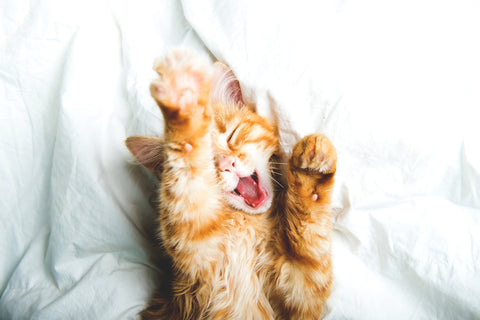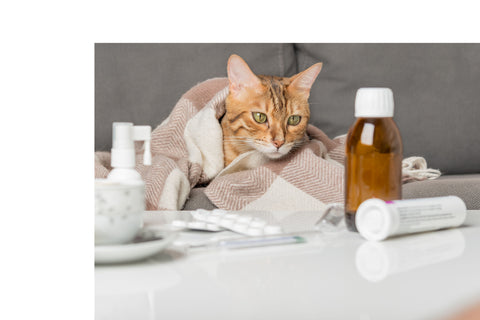
The purpose behind tooth brushing
The purpose behind tooth brushing is two-fold: your goal with brushing is to incorporate the benefits of mechanical and chemical means to remove build up of plaque. A toothbrush moved up and down the surface of a tooth provides mechanical action to remove built up plaque and tartar. Using a cat-friendly toothpaste with the toothbrush provides additional enzymes to chemically assist with the removal of plaque. This is why the gold standard used to prevent the accumulation of plaque and calculus is daily tooth brushing.
Remember, brushing your cat’s teeth is just as important as brushing our own teeth to prevent buildup of plaque and tartar!
Although daily tooth brushing at home is rarely practiced in cats, it's not a reason to give up completely on establishing an at home dental care routine. There are many ways that you can help keep your cat’s mouth healthy and prevent the buildup of plaque and tartar leading to dental disease, which can be painful, expensive, and even life-threatening.
Here are the top 5 ways to “brush” your cat’s teeth:
- Toothbrush with toothpaste
- Dental wipes
- Q-tips
- Diet & Treats
- Water additives
Toothbrush with toothpaste
Choose a cat-specific toothbrush and enzymatic toothpaste. Use a circular motion and focus on your cat’s gum line. Brush the outside and inside surface of the teeth. Start with the outside and build up to the inside once they get comfortable and more accepting. Ellen Carozza, a licensed veterinary technician in a feline-only practice recommends trying a baby toothbrush (0-2 years, step 1). The head of the brush is smaller in length and width than the finger brush and in many cases safer so the cat doesn't bite the owner.
Dental wipes
In between brushing, dental wipes can help to reduce halitosis and remove plaque build up with mechanical and chemical action. Once you’ve chosen a cat-specific dental wipe, wrap it around your index finger and once over the top to create a finger cap. Use a circular motion and focus on your cat’s gum line and back molars.
Q-tip©
Most cats will permit their caregivers to apply cotton tipped applicator sticks to the area below the gum line to decrease the daily accumulation of plaque. They will tolerate this because it stimulates their natural behavior when they rub against a person or mark their saliva on the property. Tuna water can be applied to the end of the cotton swabbed applicators (Q-tips©) for taste to gain acceptance (Jan Bellows, DVM, FAVD, DAVDC, DABVP). Make sure to select canned tuna packed in water, and not canned tuna in oil or canned tuna with added salt or other flavorings.

Diet & treats
Another great way to reduce plaque and tartar buildup is to use diet and treats especially formulated to slow down plaque accumulation mechanically, as well as chemically. The mechanical action when biting into these treats or pieces of kibble can help greatly reduce the development of tartar if used regularly.
Water additives
Along with diet and treats, cat-specific water additives can also help reduce the microbial growth in the mouth and result in improved breath. Water bowls with water additives need to be changed daily. Some cats may not like the taste or smell so it's important to make sure that your cat has access to drinking water to prevent dehydration.
Brushing your cat’s teeth at-home
Once you’ve selected a brushing method that works for you and your cat, it's very important to establish a routine with your cats. Cats respond to routine, so be consistent, taking as many breaks as needed. Pick a time of day that is quiet and when your cat is usually hungry, to get the most out of a dental care session with your cat. Positive reinforcement using their favorite treats or a play session as a reward will also help motivate your cat when it's time to get their teeth brushed! One of the keys to success is to learn to take your time and take any necessary breaks.
Brushing your cat’s teeth daily (or even several times a week) can significantly improve your cat’s risk for dental disease. Until now, there was no test that could detect the microbes in your cat’s mouth (oral microbiome) that predisposed cats to common dental conditions such as halitosis, periodontal disease and resorptive lesions. Before you start a dental care routine, test your cat’s dental biome to establish a baseline of their dental health and get personalized care recommendations based on your cat’s oral microbiome. Work together with your veterinarian to address any issues and keep up with your at-home brushing and repeat testing for ongoing monitoring of your cat’s oral health.
Remember, dental home care doesn't have to be a chore between you and your cat. What it does do is help create health habits and establish a human-cat bond.
Learn More About Dental CatKit
Resources:



